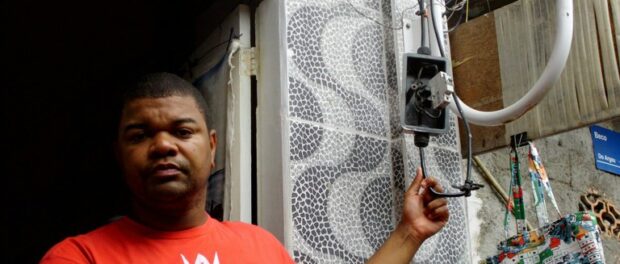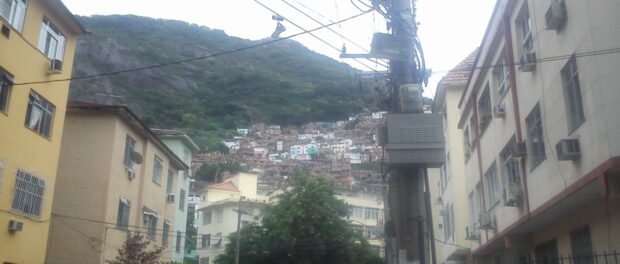
For the original article by Bruno Carvalho in Portuguese published in CartaCapital click here.
A significant rise in electricity costs cause panic and contribute to the flight of residents from communities in the South Zone of the city.
Resident of the Santa Marta favela in Rio’s South Zone for more than 30 years, Maria Helena Barbosa da Silva doubts she will be able to maintain her home on the Beco de Argeu, where she raised her four children who today are between 9 and 25 years old. The main reason for her concern is the rise in her electricity bill which absorbs much of her income. A beneficiary of Bolsa Família (federal subsidy for those in need), she has a small refrigerator, TV, and computer in her three room home. Even so, her last bill came to R$440.20 (US$121). “I even disconnected the electric shower to see if it would lower the bill. It didn’t. I even only use the iron every now and again,” she told CartaCapital.
For over six years, complaints like that of Maria Helena accumulate in every corner of Santa Marta and in various regions of Rio and the Baixada Fluminense in Greater Rio. The sudden or progressive increases in electricity bills–residents of Vidigal close to the affluent neighborhood of Leblon, for example, had increases of up to 938% on bills from one month to the next–were quickly linked to the substitution of traditional meters with electronic meters by Light, the utility responsible for supplying electricity in the city of Rio and in 31 municipalities across Rio de Janeiro state.
The installation of electronic meters has been carried out by Light since 2008 to, among other things, reduce the company’s losses from energy theft– so-called “gatos” (unofficial wire hook-ups). The network is protected by a shield box, hindering illegal connections on poles, while residents are provided with a digital display for monitoring consumption in order to prevent the tampering of the meters’ pointers. Several residents interviewed for this report, however, told that they never received the display to be able to assess their individual consumption rate.
According to Light’s latest sustainability report, in 2014 there were close to 150,000 meters installed in regions considered “high risk of energy theft” by the company and another 40,357 in favelas with Pacifying Police Units (UPPs)–among those Santa Marta.
Light first came to the Santa Marta hill in 1979 when Rio’s favelas began having access to electricity. At the time, the number of houses in Santa Marta registered with Light was 73. Today, there are 2,124 consumers registered and that increase was largely due to the installation of the state’s first UPP in the community in 2008. The following year, Light began to reform the electricity network and between 2010 and 2011 the new system came into full effect.
From then on, the first complaints from residents regarding problems with bills came in and led to action by the State Prosecutor’s Office against Light. Thiago Firmino, a tour guide and community leader, actively participated in a series of protests by residents against the concessionary and recorded video testimonials. In 2014, close to 300 people came out in heavy rain to protest on the main streets of Botafogo in the biggest demonstration of this kind.
“They (Light) came here saying they were going to improve people’s quality of life, that we would have proof of residence, that the power wouldn’t cut out any more. This little story that seems a dream began to turn into a nightmare,” said Firmino. He gave as an example the story of Francisco Vieira da Silva, the 82 year-old owner of a small bar that also served as his home and was equipped with a freezer, refrigerator, fan and TV. In two months, his bill jumped from R$380 (US$105) to R$1,252 (US$345). The situation became unsustainable and he was forced to leave the South Zone favela to live in Nova Iguaçu, in the Baixada Fluminense (2 hours by public transport).
Social scientist Pricila Loretti is completing a doctorate at Rio de Janeiro’s State University (UERJ) on the process of electricity regularization in favelas after the installation of the UPP. She sees the regularization of electricity in these areas as positive but believes there’s a dark side in that it can contribute to the process of gentrification in communities.
“The processes of regularizing services make favela residents’ lives more expensive. Without public policies that are appropriate to people’s reality, they end up being pushed to the social margins, contributing once again to reinforce the stigma of the favela as a place of crime and informality. In this context, the clandestine connections, despite their illegality, seem like an economic solution to many and are viewed as a form of income distribution,” affirms Pricila, who points out that energy theft doesn’t only occur in favelas and low-income neighborhoods.
Another point Pricila highlights is that the coincidence between the billing increases and the adoption of new technology elevated residents’ distrust and incited the conflict that began with the changes in the Social Rate for Electricity (Tarifa Social de Energia Elétrica). With the revision, people who previously qualified for the federal benefit lost the ability to receive discounts on their electricity bills. “With the implementation of this new technology, consumers lost access to the measurements of their meters, as not all customers received the display to verify their individual consumption and many didn’t know how to use the meter,” she pointed out.
Sought out for comment, Light said in a statement that the exchange of the analog meter for the digital one doesn’t impact the value of energy bills. “It is just a technological advancement. All electronic meters installed by Light are approved by the National Electricity Agency (Aneel) and the National Institute of Meterology, Quality and Technology (Inmetro),” contested the utility.
The company also affirmed that the cases of residents with very high electricity bills are being individually analyzed and that for this, it is important that consumers contact the company to be sent teams to check the situation of each client.

